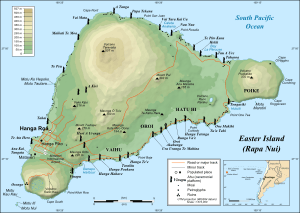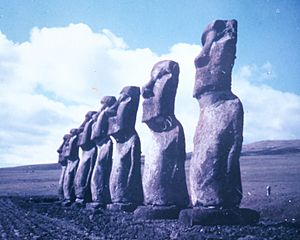Ahu Akivi facts for kids

At Ahu Akivi, the moai face the ocean. Although the platform is clearly visible, the overgrown grass obscures the pattern of the sloping pavement.
|
|
| Coordinates | 27°6′54″S 109°23′42″W / 27.11500°S 109.39500°W |
|---|---|
| Location | Easter Island |
| Designer | Rapanui people |
| Type | Sacred stone statues |
| Material | Volcanic rock |
| Length | 70m |
| Height | 16 ft |
| Beginning date | Originally 15th century |
| Completion date | Restored in 1960 |
| Dedicated to | Make Make worship |
Ahu Akivi is a special, sacred place on Easter Island, also known as Rapa Nui, which belongs to Chile. It faces the vast Pacific Ocean. This site has seven large stone statues called moai. They are all the same shape and size. People believe it was also an observatory, used to study the sky, built around the 1500s. Unlike many other moai, these statues are found inland, not right by the coast.
The early people of Rapa Nui thought the moai statues were their ancestors, called Tupuna. They believed these statues were important kings or leaders who had come back to life. The moai were put up to protect their families and villages, and to bring them good luck.
A cool thing about these seven identical moai statues is how they are placed. They look exactly towards where the sun sets during the Spring Equinox. Their backs are to the sunrise during the Autumn Equinox. This amazing, precise alignment with the stars is only found at this one spot on the island.
| Top - 0-9 A B C D E F G H I J K L M N O P Q R S T U V W X Y Z |
Where is Ahu Akivi Located?
Ahu Akivi is found on the side of a southern hill called Maunga Terevaka, on Rapa Nui. It is surrounded by flat land used for farming. The site is about 2.3 kilometers (1.4 miles) away from the coast. It sits at a height of 140 meters (460 feet) above sea level.
To get to Ahu Akivi from Hanga Roa, the capital city, you can take an inland road. This road goes past the volcano called Terevaka, which is 510 meters (1,670 feet) tall. There's also a coast road that goes by Anakena Beach. Along this road, you can see many moai statues that are still lying down and haven't been put back up.
Some paths from the main road lead to Puna Pau. This is a quarry, a place where rocks are dug out. It's a small volcanic crater with red rocks called scoria. These red rocks were used to carve the "top hats" of the statues, known as pukao. These pukao might have looked like hair buns, grass hats, or turbans. Ahu Akivi is about 10 kilometers (6 miles) northeast of Hanga Roa.
The Rano Raraku quarry, where most of the moai statues were carved, is at least 15 kilometers (9 miles) away. People could get there easily by land, as different family groups controlled the routes.
The History of Ahu Akivi
Ahu Akivi is part of a larger area called the Ahu Akivi-Vai Teka complex. The Rapanui people built this complex in two main stages.
The first stage happened in the 1500s. They made a flat, rectangular platform in the center. This platform had parts sticking out to the north and south. There was also a ramp leading up to a special area for ceremonies, which stretched 25 meters (82 feet) to the west. A place for cremation (burning bodies) was located behind the main platform.
The second stage of building was much more detailed. It took place in the early 1600s. The platform was changed, a new ramp was built, and the seven equally sized statues were put up. Another cremation area was also added. There was even a cave nearby that people used to live in, which later became a tomb.
Another platform in this complex is called Ahu Vai Teka. It's much smaller, about 16 meters (52 feet) long, and made of rough lava stones. There isn't a statue there now, but people think there might have been one in the past. Both Ahu Akivi and Ahu Vai Teka were believed to be lined up with the sun and stars. Both sites were in the area of the Miru, who were the most important family group on the island.
It's thought that the seven statues at Ahu Akivi were placed there at least 150 years before the first Europeans arrived on the island. This shows that the Rapanui culture was strong and successful for 250 to 300 years, with a good economy and stable leaders.
In 1955, a famous explorer named Thor Heyerdahl asked an American archaeologist named William Mulloy and his Chilean friend, Gonzalo Figueroa García-Huidobro, for help. They worked together to put the statues back in their original spots in 1960. They had found the statues knocked down. Mulloy's work on Ahu Akivi was supported by several groups, including the Fulbright Foundation and universities. Ahu Akivi also gives its name to one of the seven areas of Rapa Nui National Park.
The Legend of Ahu Akivi
Most moai statues on Easter Island face inland, looking towards the villages to protect them. But the moai at Ahu Akivi are different; they face the sea. There's a special story about why these seven statues face the ocean.
Some people think the Rapanui people did this to ask the sea for help for their sailors. However, an old story says that the priest of King Hotu Matu'a had a dream. In his dream, the king's spirit flew across the ocean and saw Rapa Nui island. So, the king sent seven scouts to sail across the sea to find the island and bring people to live there. These seven scouts stayed on the island, waiting for the king to arrive. The seven stone statues at Ahu Akivi are said to represent these seven brave scouts, put up to honor them.
What Makes Ahu Akivi Special?
Archaeologists have studied the different parts of an Ahu platform. They look at things like how long the platform is, if its back wall is made of rough or fine stones, if it has "wings" (side parts), how many statues it has, if it has a red scoria "top knot" (headgear), a ramp, a cremation area, a paved plaza, a well-made front wall, and a decorative edge made of red scoria.
Ahu Akivi has almost all of these features. The only difference is that the back part of its platform is made of rough stone. Another interesting fact is that some of the stones used to build the platform's foundation are not from Easter Island. They were brought as heavy cargo on a ship in the 1800s.
During their digs, archaeologists also found stone disks, small statues, and fish hooks made of stone and bone. These items suggest that burial ceremonies were held at this site.
The seven moai statues at Ahu Akivi are placed with amazing accuracy to line up with the sky. This sacred observatory and sanctuary, with all seven moai, looks exactly towards where the sun sets during the equinox. It also lines up with the moon. Each statue is about 16 feet (4.9 meters) tall and weighs around 18 tons (16,300 kg). The entire platform is 70 meters (230 feet) long.
When archaeologists dug here, they also found molds of tree roots. This shows that the area used to have trees and plants growing there a long time ago.
Restoring the Moai
In 1960, when the American archaeologist William Mulloy and his team restored the statues, it took them one month to lift and set the first moai in place. They used a stone ramp and two wooden levers to do this difficult job. However, they learned quickly and it took them less than a week to raise the seventh moai!
See also
 In Spanish: Ahu Akivi para niños
In Spanish: Ahu Akivi para niños




